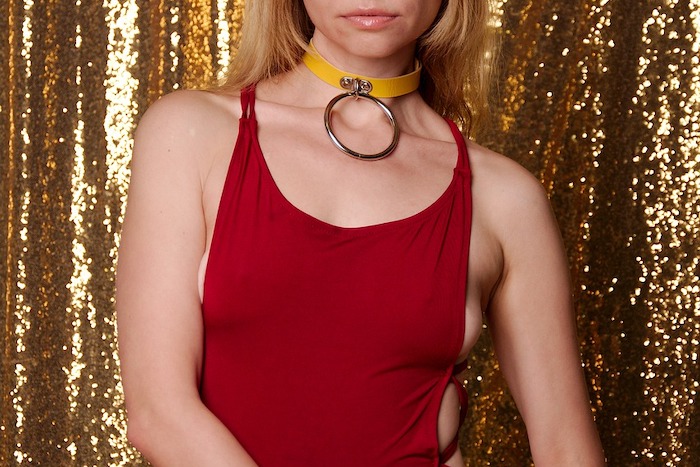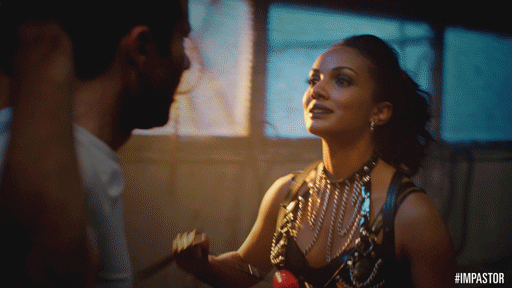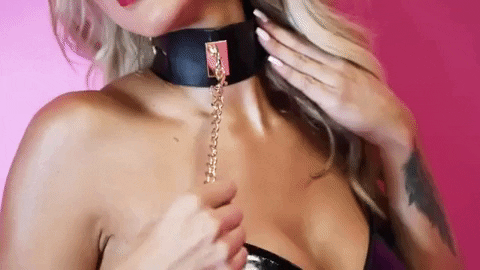The collar kink is a hot topic of discussion in the BDSM community. Not everyone sees it the same but most agree that collars are a public expression of their relationship. In fact, many subs don’t feel like they’re truly owned without one. If you’re curious about collars or just want to add them as a more serious part of your relationship, you may find the information below interesting.
What is a BDSM Collar?

A BDSM collar is a piece of jewelry or trinket, such as a simple necklace ring, or even a keychain. It is usually made of durable material and is often decorated with spikes, studs, or other types of embellishments. Collars are typically worn around the neck, but can also be worn on other parts of the body such as the wrists or ankles.
BDSM collars are used for a variety of purposes. They can be used as a form of punishment, as a way to show ownership, or as a way to show submission. It’s also seen as a sign of commitment to the BDSM lifestyle. Some people also wear BDSM collars as a form of fashion statement.
There are many different bondage collar styles available on the market today. Some of the most popular ones include:
- Choker Collars – This is the most popular type of bondage collar. It’s usually made from leather or metal, and it fits snugly around the neck.
- Collar with D-ring – This is similar to a choker collar, but it has a D-ring attached to the front. This allows the wearer to attach a leash or other type of restraint to the front of the collar.
- Collar with O-ring – This is similar to choker collars with D-ring. But instead of a D-ring, it has an O-ring attached to the front where you can attach a leash or other type of restraint.
- Collar with Chain – This type of collar has a chain attached to the front. This allows the wearer to attach a leash or other type of restraint to the front of the collar.
- Collar with Buckle – This looks like a regular choker collar but has a buckle attached to the front. This allows the wearer to adjust the tightness of the collar.
There are also many different types of materials that can be used to make bondage collars. Some of the most popular materials include:
- Leather – This is the most popular type of material used to make bondage collars. It’s strong and durable, and it can be easily cleaned.
- Metal – This is another popular type of material used to make bondage collars. It’s strong and durable, but it’s not as easy to clean as leather.
- Plastic – This is the least popular type of material because it’s not as strong or durable as leather or metal. but it’s easier to clean.
6 Types of Collars
All collars serve the same purpose, which is to show ownership. But not all have the same meaning or purpose. We’ve listed the six most common types of collars and explained them as best we could to help you understand the collar kink more.
1. Consideration collars
A collar of consideration is typically worn in a master/slave relationship dynamic but not always. It’s also commonly seen in new relationships because, as the name implies, the collared person is under consideration to be someone’s permanent partner.
2. Training collars

This is often the next step after the consideration collar. This type of collar is worn by subs while being trained. Doms use it as a form of punishment or reward to enforce rules and expectations. This helps their submissive learn obedience, submission, and other desired behaviors. Once training is complete, both parties may level up to a permanent collar or end the relationship.
3. Protection collars
A BDSM protection collar is a temporary collar often gifted to new subs by someone who has a lot of experience in the kink scene. Subs who want to be left alone by doms may also seek the help of someone who can afford them protection.
Although a protection collar is temporary, the dominant who provides the collar takes full responsibility for the sub who wears it. At the same time, the person wearing it represents the dom providing protection. There’s no expectation of training or a long-term commitment with this setup. Of course, there’s the possibility that the person offering protection is actually just trying to sneakily get into the sub’s pants.
4. Day collars

A BDSM day collar is a type of collar that is worn during the day as a symbol of the submissive’s submission to their dominant. It could be a necklace or a choker with a very plain design to help it go unnoticed by vanilla eyes. A day collar is usually made of leather or fabric and is often decorated with symbols of submission, such as a heart or a key.
5. Play collars
A play collar is the most relaxed type of collar on this list. And because it’s widely used for fun and play, it immediately prepares the sub for the kinky fuckery that’s about to come. It’s especially useful during pet play scenes because of the D-ring on it which can be attached to a leash.

It’s a strong reminder of the power exchange in the relationship. But when worn at BDSM events, it doesn’t always signify that the sub is owned. It may simply mean that they’re committed for the night or session.
6. Permanent collars
A permanent collar is a collar worn at all times, even when the submissive is not with their dominant. It can be worn under clothing or as a piece of jewelry. A permanent collar can be made from any material, but it is often made from metal, leather, or cloth. It is important to choose a collar that is comfortable to wear and will not cause any skin irritation.
Moving up to this collar is a huge step. It’s a sign of commitment and ownership. It shows that the submissive belongs to the dominant and is not free to leave. It’s as binding as a wedding ring. When taken off, it usually means the relationship is over.
Choosing the Right Training Collar
There are many options when it comes to style and design, but collars aren’t just some piece of jewelry or trinket. It’s an integral part of the D/s relationship, so choosing the right one is important. A good training collar should:
- Be comfortable to wear
- Be made of durable materials that can withstand repeated use
- Be adjustable to fit a variety of neck sizes
- Have a D-ring or other attachment points for attaching a leash
- Be easy to put on and take off
- Be comfortable to wear for extended periods of time
- Not chafe or cause skin irritation
- Be easy to clean
- Be stylish and attractive
- Be affordable
Permanent Collar Options for Doms

Doms wearing a collar isn’t a common practice, but it’s not unheard of. In fact, many wear bracelets, rings, or necklaces to represent their dominance. Other options include keychains, cufflinks, and tie clips with engravings. A dom collar could also be a gift from their sub. For example, littles in DDLG relationships can make their caregiver a bracelet out of beads.
Aside from showing their role as the dominant partner, doms wear a collar to show ownership and control of themselves. To them, it’s a constant reminder to strive to be the best person they can be. Plus, it’s a promise to show themselves the same high expectations and respect they show their slaves. After all, why would a submissive want to be controlled by someone who can’t take responsibility for themselves?
9 BDSM Collar Etiquette and Training Protocols
Just like any other BDSM kink, the collar fetish also has its own set of rules. But don’t let the word “rule” scare you. The etiquette for collars is pretty simple.
Here are nine simple rules to follow if you want to give this kink a try.
- Always ask before putting on or taking off a collar.
- Never force someone to wear a collar.
- Respect a person’s decision to wear or not wear a collar.
- If you are wearing a collar, be aware of its symbolism and be respectful of it.
- Never use a collar as a weapon or tool of coercion.
- Collars should be comfortable and not cause undue physical discomfort.
- Be aware of the different types of collars and their meanings.
- Never assume that someone is submissive simply because they’re wearing a collar.
- A collar is not a replacement for communication, consent, and respect.
How is a Collar Similar to a Wedding Ring?

A permanent collar is similar to a wedding ring in that they are both worn around the finger/neck and are a symbol of love and commitment. It’s not something you can just take off anytime you want. But it means more than any piece of documentation saying you’re legally married. It’s a permanent reminder of the bond between the people involved and the power dynamic in the relationship.
Removing the collar is a serious offense. Subs need permission to do so even if they’re only removing it for a few minutes to take a bath. Of course, subs can revoke consent and remove a collar. It helps to agree on a formal method of uncollaring if it ever comes to that. Returning a collar is like returning an engagement ring.
That’s how important collars are to people in D/s relationships. If you’re not into this kink, nobody will force you. Likewise, if you want something special to symbolize your relationship but are not into collars, you can pick another item. Your collar should represent you and reflect your relationship after all.





